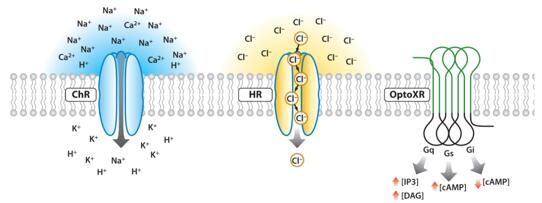Optogenetics, which use the genetically coded, light-gated ion channels and pumps (opsins) to excite or inhibit neurons, enables fast and focused in vivo manipulation of neural activity. Opsins belong to a protein family of light-sensitive, which vias the chromophore retinal (or a variant) found in photoreceptor cells of the retina. By targeting opsin expression to specific cell types or neuronal pathways, optogenetics can investigate in understanding of the neural activity of normal and pathological behavior with a millisecond resolution. For getting an insight into human cognition and behavior, optogenetics has been used in multiple animal models, especially applied in nonhuman primates (NHPs).
With difference from the traditional physical and chemical stimulus, optogenetics offers a completely novel method, which is to use light directly to stimulate cells at the right time and place. Light-sensing protein play a crucial role in optogenetics research and give an insight into precise and spatiotemporal control of neuron activity.
At Profacgen, two types of photosensitive proteins can be provided: activated and inhibited, which can cause neurons to excite or inhibit.
| Activated channel proteins | Inhibitory channel proteins | |||
|---|---|---|---|---|
| ChR2(H134R) | ChR2(C128S/D156A) | C1V1 | NpHR | |
| ChETA | ChR2(E123T/T159C) | ReaChR | eNpHR2.0 | eNpHR3.0 |
| OptoXR | Arch | Mac | ||
The activation or inhibition ability is closely related to the precise control of time. Therefore, finding the appropriate light-sensitive protein according to the different characteristics of the light-sensitive protein is the first step. With a virus vector, such as adeno-associated virus (AAV) and Lentivirus, then light-sensing genes (such as ChR2, NpHR3.0, Arch, or OptoXR, etc.) can be transfer into specific cells in the nervous system for special ion channel or GPCR expression. Optical signal was controlled with different parameters (wavelength, light intensity, frequency and duty cycle) and a selective local part of the cell for generation a light stimulation to achieve the regulation of neuronal activity at high spatial and temporal resolution.

Figure 1 Optogenetic tool families. Channelrhodopsins (ChR) conduct cations and depolarize neurons upon illumination (left). Halorhodopsins (HR) conduct chloride ions into the cytoplasm upon yellow light illumination (center). OptoXRs are rhodopsin-GPCR (G protein–coupled receptor) chimeras that respond to green (500 nm) light with activation of the biological functions dictated by the intracellular loops used in the hybrid (right).
Optogenetics had been used in diverse animal models, such as zebrafish, mouse, rat, nonhuman primate, etc. At Profacgen, we have our skilled and motivated team of employees with highly specialized scientific backgrounds, and we are focused on innovative technologies to provide our customer with a set of optogenetics services. With our in-house optogenetic imaging system, we can provide our customer the precise analysis and regulation of neural circuits and get insight into the treatment of neuropsychiatric diseases.
For more information regarding Profacgen’s protein analysis services, please contact us at info@profacgen.com. Our customer service representatives are available 24 hours a day, Monday through Friday, to assist you.
1. Aristides B. Arrenberg, Filippo Del Bene, and Herwig Baier, Optical control of zebrafish behavior with halorhodopsin. Proc Natl Acad. Sci. 2009; 106(42): 17968-17973.
2. Lief Fenno, Ofer Yizhar, and Karl Deisseroth, The Development and Application of Optogenetics. Annu Rev Neurosci. 2011; 34: 389-412.
3. Adriana Galvan, XWilliam R. Stauffer, Leah Acker et. al. Nonhuman Primate Optogenetics: Recent Advances and Future Directions. J Neurosci. 2017; 37(45): 10894-10903.
Fill out this form and one of our experts will respond to you within one business day.